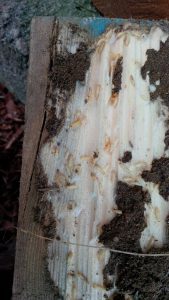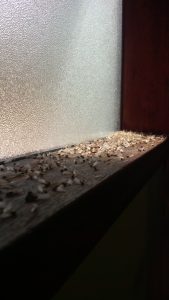7 THINGS TO KNOW ABOUT TERMITES AND YOUR HOME
By Chris Williams on August 9, 2018.
In the Northeast, our primary termite pest (the one that causes most of the damage to structures) is the eastern subterranean termite. Knowing a little bit about this termite and being able to recognize early signs of infestation can mean the difference between eliminating a problem early and having to pay for an extensive termite treatment and major structural repairs.
1. In almost all cases, subterranean termites do not live inside the wood in your home. They live in a colony, governed by a queen, in the soil outside and travel to your house, deck, garage, etc. to feed on wood there, returning to the colony periodically.
2. Because termites are soft-bodied and susceptible to drying out, they search for wood by traveling underground, or they move through narrow mud tubes that they construct for that purpose when they have to leave the soil (see Could These Mud Tubes Be From Termites?).
3. Subterranean termites prefer, and usually first infest, wood that is damp or has been damaged by water in the past. Areas where there may have been a roof leak, plumbing leak, or where there are condensation, moisture, or drainage issues are most susceptible to termites.
4. An insecticide barrier treatment of the soil around your home (often required for new construction) prevents termites from reaching your home. However, work around the foundation such as landscaping, drainage or utility work, or renovation can break that termite barrier. In-ground termite bait monitors around the foundation can also offer termite protection.
5. If not blocked, termites can enter your home through cracks in the slab, crevices around the foundation, openings around conduits, etc., or they can move from the soil directly into the wood if wood on your house is buried in or touches soil, or if they can tube over an open space to reach the wood (see Termites Are Attracted by Certain Conditions).

Termite workers feeding on wood which was on the ground. Z. Ciras
6. Soft-bodied, white termite workers are rarely seen as they work inside the wood, chewing layered galleries that follow the grain and may be plastered with soil and fecal spots. Interior wood damage may not be visible from the outside of the wood at first. Eventually, only a thin outer shell remains intact and can easily be penetrated with a screwdriver (see What Does Termite Damage Look Like?).

Termite swarmers in a window. Z. Ciras
7. When termite colonies are old enough and large enough, they produce black winged reproductives or swarmers. Swarming usually occurs in spring, often after a rain and is a common occurrence outside from various ground colonies (see When Do Termites Swarm?). When many swarmers are seen inside, it’s a good indication that termites are infesting within the structure.
If you’re worried about termites, damp susceptible areas in your home, or if you’re not sure if your home is still protected from termites, give Colonial Pest a call. We can inspect for termites and conditions that attract termites. We also offer installation of termite bait monitors to protect your home.
For more on how termite bait monitoring stations work, take a look at this and call Colonial: All About Termite Baiting Systems